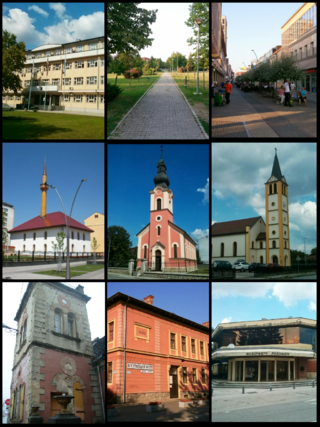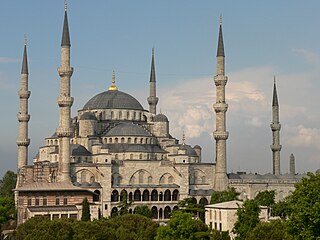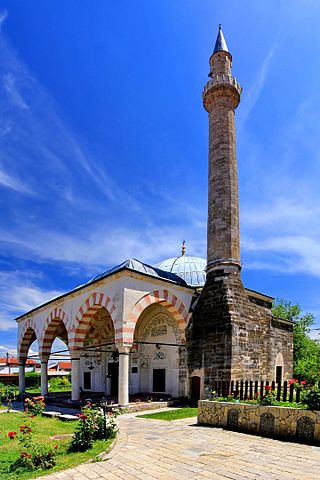
The Blue Mosque in Istanbul, also known by its official name, the Sultan Ahmed Mosque, is an Ottoman-era historical imperial mosque located in Istanbul, Turkey. It was constructed between 1609 and 1617 during the rule of Ahmed I and remains a functioning mosque today. It also attracts a large number of tourists and is one of the most iconic and popular monuments of Ottoman architecture.

The Bajrakli Mosque is a mosque in Belgrade, the capital of Serbia. It is located in Gospodar Jevremova Street in the neighbourhood of Dorćol. It was built around 1575, and is the only mosque in the city out of the 273 that had existed during the time of the Ottoman Empire's rule of Serbia.

Mimar Sinan also known as Koca Mi'mâr Sinân Âğâ, was the chief Ottoman architect, engineer and mathematician for sultans Suleiman the Magnificent, Selim II and Murad III. He was responsible for the construction of more than 300 major structures, including the Selimiye Mosque in Edirne, the Kanuni Sultan Suleiman Bridge in Büyükçekmece, and the Mehmed Paša Sokolović Bridge in Višegrad, as well as other more modest projects such as madrasa's, külliyes, and bridges. His apprentices would later design the Sultan Ahmed Mosque in Istanbul and the Stari Most bridge in Mostar.

Prijedor is a city and municipality in Republika Srpska, Bosnia and Herzegovina. As of 2013, it had a population of 89,397 inhabitants within its administrative limits. Prijedor is situated in the northwestern part of the Bosanska Krajina geographical region.

Ottoman architecture is an architectural style or tradition that developed under the Ottoman Empire over a long period, undergoing some significant changes during its history. It first emerged in northwestern Anatolia in the late 13th century and developed from earlier Seljuk Turkish architecture, with influences from Byzantine and Iranian architecture along with other architectural traditions in the Middle East. Early Ottoman architecture experimented with multiple building types over the course of the 13th to 15th centuries, progressively evolving into the classical Ottoman style of the 16th and 17th centuries. This style was a mixture of native Turkish tradition and influences from the Hagia Sophia, resulting in monumental mosque buildings focused around a high central dome with a varying number of semi-domes. The most important architect of the classical period is Mimar Sinan, whose major works include the Şehzade Mosque, Süleymaniye Mosque, and Selimiye Mosque. The second half of the 16th century also saw the apogee of certain decorative arts, most notably in the use of Iznik tiles.

Uzunköprü is a town in Edirne Province in Turkey. It is named after a historical stone bridge, claimed to be the world's longest, on the Ergene River. It is a strategically important border town, located on the routes connecting Turkey to the Balkans and Europe. It is the seat of Uzunköprü District. Its population is 39,577 (2022). Uzunköprü is the third most populous town of Edirne Province.

Prusac (Прусац) is a village in Bosnia and Herzegovina in the Central Bosnia Canton of the Federation of Bosnia and Herzegovina. It is one of the oldest villages in the Skopaljska valley located in the upstream area of the Vrbas river. It is located a few kilometres from Donji Vakuf.

The architecture of Serbia has a long, rich and diverse history. Some of the major European style from Roman to Postmodern are demonstrated, including renowned examples of Raška, Serbo-Byzantine with its revival, Morava, Baroque, Classical and Modern architecture, with prime examples in Brutalism and Streamline Moderne.

The Klis Fortress is a medieval fortress situated above the village of Klis, near Split, Croatia. From its origin as a small stronghold built by the ancient Illyrian tribe Dalmatae, to a role as royal castle and seat of many Croatian kings, to its final development as a large fortress during the Ottoman wars in Europe, Klis Fortress has guarded the frontier, being lost and re-conquered several times throughout its two-thousand-year-long history. Due to its location on a pass that separates the mountains Mosor and Kozjak, the fortress served as a major source of defense in Dalmatia, especially against the Ottoman Empire. It has been a crossroad between the Mediterranean Sea and the Balkans.

Old St. Nicholas Church or Wooden church in Javorani in Javorani is Serbian Orthodox church in Bosnia. The church is dedicated to St. Nicholas. Church was built in 1756.
Monuments of Kosovo comprise all the monuments that are located in Kosovo.

The Çelebi Sultan Mehmed Mosque, also known as the Bayezid Mosque and the Great Mosque, is an early 15th-century Ottoman mosque in Didymoteicho, East Macedonia and Thrace, in the far northeast of Greece.

The Hadum Mosque in Gjakova, Kosovo was built in the last decade of the 16th century (1594/95) and was financed by Hadum Sylejman Efendia – Hadum Aga, which explains the name of the mosque. The mosque was built on the property of Jakë Vula and is located in the Old Bazaar. A rectangular, dome-covered structure, it belongs to the classic forms of mosque of the Islamic-Kosovar style. Around the mosque there are tombs with sculpted decorations and engraved with epithets in the old Ottoman language. The tombs belonged to the most respected families in Gjakova. There also used to be a "hamam", but it was destroyed during World War II. The entrances are covered with floral paintings, geometrical shapes, citations from the Kur'an and arabesques. In 1999, the surrounding complex was burned to the ground and only the mosque and the minaret along with some damaged arabesques survived.
Mitrovica is one of the oldest settlements in Kosovo and a very important urban ensemble. There are many traces which have special interest and prove early civilization of the territory of Mitrovica, in particular from the Illyrian inhabitation in antiquity.

The Church of Saint George, Sopotnica is a Serbian Orthodox church and the protected National Monument located at the village of Donja Sopotnica in the Municipality of Novo Goražde in eastern Republika Srpska, Bosnia and Herzegovina. The church stands on the left bank of the Drina River, four kilometres from the town of Goražde. The church was built in 1454 and expended in 1455. Its benefactor was Stjepan Vukčić Kosača, while the patron saint of this church is Saint George of Lydda.

The Ioannina Castle is the fortified old town of the city of Ioannina in northwestern Greece. The present fortification dates largely to the reconstruction under Ali Pasha in the late Ottoman period, but incorporates also pre-existing Byzantine elements.

Kruszyniany Mosque is a wooden mosque located in the village of Kruszyniany, in Podlaskie Voivodeship, Poland. The building is the oldest Lipka Tatar mosque in Poland, built on the plan of a rectangle, in specifications of 10 by 13 metres.

The St. Mark's Church is a church in the town of Užice, in western Serbia. It is noted for its appearance, as an old, small, mostly wooden church in the town's modern urban setting. Originally constructed in 1721, it was rebuilt in 1828 and is the oldest surviving church in the entire Užice region. It was protected by the state in 1951 and declared a Cultural Monument of Great Importance in 1987. The church is colloquially called by the residents the Small Užice Church.
Lazar Jovanović was a Bosnian Serb manuscript writer from the first half of the 19th century. He worked as a teacher at Serb elementary schools in Tešanj and Tuzla, in the north-east of the Ottoman province of Bosnia. He wrote, illuminated and bound two books in 1841 and 1842. The first book was commissioned by Serb members of the guild of goldsmiths in Sarajevo. It contains a collection of advice to be presented to journeymen on the ceremony of their promotion to master craftsmen. His second book contains a version of the apocryphal epistle known as the Epistle of Christ from Heaven. Although Jovanović states that he writes in Slavonic-Serbian, the language of his books is basically vernacular Serbian of the Ijekavian accent. He follows traditional Church Slavonic orthography, rather than the reformed Serbian Cyrillic introduced in 1818.

Classical Ottoman architecture is a period in Ottoman architecture generally including the 16th and 17th centuries. The period is most strongly associated with the works of Mimar Sinan, who was Chief Court Architect under three sultans between 1538 and 1588. The start of the period also coincided with the long reign of Suleiman the Magnificent, which is recognized as the apogee of Ottoman political and cultural development, with extensive patronage in art and architecture by the sultan, his family, and his high-ranking officials.



























